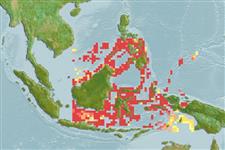Common names from other countries
Environment: milieu / climate zone / depth range / distribution range
Sinh thái học
. Tropical; 23°C - 30°C (Ref. 102835); 13°N - 9°S, 109°E - 139°E (Ref. 106696)
Western Central Pacific: Restricted in the tropical western Pacific. From Sabah, Malaysia to Palau, north to Philippines and south to Indonesia.
Length at first maturity / Bộ gần gũi / Khối lượng (Trọng lượng) / Age
Maturity: Lm ? range ? - ? cm Max length : 41.1 cm SHL con đực/không giới tính; (Ref. 117184); common length : 20.0 cm SHL con đực/không giới tính; (Ref. 348)
Its shell is thinner and smoother than that of H. hippopus, usually devoid of pigmentation, and more semi-circular in profile. The mantle is similar to that of H. hippopus (Rosewater, 1982), except that prominent papillae line the margins of the incurrent siphon.
Collected for food and shell (Ref. 348).
Life cycle and mating behavior
Chín muồi sinh dục | Sự tái sinh sản | Đẻ trứng | Các trứng | Sự sinh sản | Ấu trùng
Broadcast spawners. Life cycle: Embryos develop into free-swimming trocophore larvae, succeeded by the bivalve veliger, resembling a miniature clam (Ref. 833).
Poutiers, J.M. 1998. (Ref. 348)
IUCN Red List Status (Ref. 130435: Version 2024-1)
CITES status (Ref. 108899)
Not Evaluated
Threat to humans
Harmless
Human uses
Các nghề cá: Tính thương mại
FAO - Nuôi trồng thủy sản: Sản xuất; | FishSource | Biển chung quanh ta
Các công cụ
Các nguồn internet
Estimates based on models
Thích nghi nhanh
thấp, thời gian nhân đôi của chủng quần tối thiểu là 4.5 - 14 năm (K=0.13).
Vulnerability
Moderate to high vulnerability (51 of 100).
Price category
Unknown.
